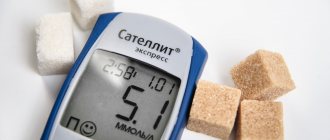Sugar curve - test for glucose tolerance.
The glucose tolerance test (sugar curve) is a simple but very valuable test, indispensable for assessing carbohydrate metabolism, i.e.
to detect diabetes and prediabetes. The test is carried out as follows. The patient comes to the laboratory in the morning on an empty stomach, after 8-14 hours of fasting, and takes a blood test for sugar (glucose). The analysis must be done immediately. If fasting blood sugar does not exceed 7.0 mmol/l, then the patient drinks a glass of water in which 75 grams of glucose is dissolved. This is a standard, fixed amount of carbohydrates for which standards have been developed. You cannot replace glucose with granulated sugar or another sweet drink. You can add a little lemon juice to the glucose solution for a more pleasant taste.
2 hours after taking glucose, the patient donates blood again for sugar. In the case of pregnant women, blood is donated after 1 hour and after 2 hours. The patient must sit and not walk or lie down during the entire examination. You should also refrain from smoking before and during the test.
Sugar curve - glucose tolerance test
A blood test for glucose must be carried out in the laboratory using special devices - analyzers with high accuracy. Glucometers cannot be used to carry out the test, as their error of change is too great.
An oral glucose tolerance test consists of determining the level of plasma glucose on an empty stomach and 2 hours after a carbohydrate load in order to diagnose various disorders of carbohydrate metabolism (diabetes mellitus, impaired glucose tolerance, fasting glycemia).
The research results are provided with a free doctor’s commentary.
Synonyms Russian
Oral glucose tolerance test (OGTT), a test for glucose tolerance, a test with 75 grams of glucose.
English synonyms
Glucose tolerance test (GTT), oral glucose tolerance test (OGTT).
Research method
Enzymatic UV method (hexokinase).
Units
mmol/l.
What biomaterial can be used for research?
Venous blood.
How to properly prepare for research?
- An oral glucose tolerance test should be performed in the morning after at least 3 days of unrestricted nutrition (more than 150 g of carbohydrates per day) and normal physical activity. The test should be preceded by an overnight fast for 8-14 hours (you can drink water).
- Your last evening meal should contain 30-50 grams of carbohydrates.
- Do not drink alcohol 10-15 hours before the test.
- Do not smoke the night before the test and until it is over.
General information about the study
An oral glucose tolerance test should be performed in the morning after at least 3 days of unrestricted nutrition (more than 150 g of carbohydrates per day) and normal physical activity. The test should be preceded by an overnight fast for 8-14 hours (you can drink water). The last evening meal should contain 30-50 g of carbohydrates. Do not smoke the night before the test and until it is over. After taking blood on an empty stomach, the subject should drink 75 g of anhydrous glucose or 82.5 g of glucose monohydrate dissolved in 250-300 ml of water within no more than 5 minutes. For children, the load is 1.75 g of anhydrous glucose (or 1.925 g of glucose monohydrate) per kg of body weight, but not more than 75 g (82.5 g); for children weighing 43 kg or more, the usual dose (75 g) is given. Smoking and vigorous physical activity are not allowed during the test. After 2 hours, blood is taken again.
It should be remembered that if the fasting blood glucose level exceeds 7.0 mmol/l, then the oral glucose tolerance test is not performed, since this blood glucose level itself is one of the criteria for diagnosing diabetes mellitus.
An oral glucose tolerance test allows you to diagnose various disorders of carbohydrate metabolism, such as diabetes mellitus, impaired glucose tolerance, fasting glycemia, but cannot clarify the type and causes of diabetes mellitus, and therefore, after receiving any result of an oral glucose tolerance test, it is advisable to conduct a mandatory consultation endocrinologist.
What is the research used for?
For diagnostics:
- diabetes mellitus;
- impaired glucose tolerance;
- fasting glycemia.
When is the study scheduled?
- In case of questionable glycemic values, to clarify the state of carbohydrate metabolism;
- when examining patients with risk factors for developing diabetes mellitus: age over 45 years;
- BMI more than 25 kg/m2;
- family history of diabetes (parents or siblings with type 2 diabetes);
- habitually low physical activity;
- presence of fasting glucose or a history of impaired glucose tolerance;
- gestational diabetes mellitus or a history of birth of a fetus weighing more than 4.5 kg;
- arterial hypertension (of any etiology);
- lipid metabolism disorder (HDL level below 0.9 mmol/l and/or triglyceride level above 2.82 mmol/l);
- the presence of any disease of the cardiovascular system.
When is it appropriate to perform an oral glucose tolerance test to screen for carbohydrate metabolism disorders?
| Age of onset screening | Groups in which screening is carried out | Frequency of examination |
| > 45 years old | With normal body weight and no risk factors | If the result is normal – once every 3 years |
| Any adult | With BMI > 25 kg/m2 + 1 risk factor | If the result is normal – once every 3 years Persons with impaired glucose tolerance, fasting glycemia - once a year |
When should an oral glucose tolerance test not be performed?
- Against the background of any acute disease, including infectious.
- While taking medications that increase glycemic levels (glucocorticoids, thyroid hormones, thiazides, beta blockers, oral contraceptives). Cancellation is required (according to doctor's recommendations) 3 days before the test.
What do the results mean?
Reference values
Performed at two time points, reference values of glucose in the blood plasma for each point in the study results are given in accordance with the “Algorithms for specialized medical care for patients with diabetes mellitus” (2017):
| Determination time | Reference values of glucose, venous blood, mmol/l |
| On an empty stomach | ˂ 6,1 |
| 2 hours after OGTT | ˂ 7,8 |
Criteria for determining impaired fasting glycemia, impaired glucose tolerance and diabetes during GTT
| Determination time | Glucose level, venous blood, mmol/l |
| Impaired fasting glycemia | |
| On an empty stomach | ≥ 6.1 and ˂ 7.0 |
| 2 hours after OGTT (if determined) | ˂ 7,8 |
| Impaired glucose tolerance | |
| Fasting (if determined) | ˂ 7,0 |
| 2 hours after OGTT | ≥ 7.8 and ˂ 11.1 |
| Diabetes | |
| On an empty stomach | ≥ 7,0 |
| 2 hours after OGTT | ≥ 11,1 |
| For any random determination | ≥ 11,1 |
Reasons for increased blood glucose levels:
- various disorders of carbohydrate metabolism (diabetes mellitus, impaired glucose tolerance, fasting glycemia);
- false positive result - a recent or ongoing acute illness, surgery or any other stressful situation, taking medications that increase glycemic levels (glucocorticoids, thyroid hormones, thiazides, beta blockers, oral contraceptives).
Reasons for low blood plasma glucose levels:
- taking medications that reduce glycemic levels (insulin, various sugar-lowering drugs);
- insulinoma;
- excessive fasting;
- intense physical activity on the eve of the test.
How to evaluate the results of the sugar curve?
In a healthy person, blood sugar from a vein on an empty stomach is no higher than 6.1 mmol/l, and 2 hours after a meal or glucose load is 7.8 mmol/l.
If fasting sugar is 7.0 mmol/l and higher, or after 2 hours is higher than 11.0 mmol/l, then diabetes mellitus is diagnosed. If the sugar levels are between normal and diabetic, then this is prediabetes (the diagnosis will sound like impaired glucose tolerance or impaired fasting glycemia).
For pregnant women, the norms are different - on an empty stomach less than 5.1 mmol/l, after 1 hour no higher than 10.0 mmol/l, after 2 hours no higher than 8.5 mmol/l. If blood sugar is higher than normal in at least one measurement, diabetes is diagnosed.
When is a glucose tolerance test prescribed?
The test is prescribed to patients at high risk for diabetes. This group includes:
- suffering from excess weight, arterial hypertension, heart and vascular diseases,
- having close relatives with diabetes,
- leading a sedentary lifestyle,
- patients who had hyperglycemia in a stressful situation (during pneumonia, heart attack, stroke).
In pregnant women, risk factors are:
- BMI is more than 30,
- history of birth of a child weighing more than 4.5 kg,
- history of polycystic ovary syndrome,
- having close relatives with diabetes,
- development of gestational diabetes in previous pregnancies.
GTT is not advisable for patients who have identified laboratory signs of diabetes mellitus (blood glucose level over 7.0 mmol/l).
Prediabetic condition: causes
The main causes of impaired glucose tolerance are the following:
- significant excess weight, in the development of which the main factors are transmission and a sedentary lifestyle;
- genetic predisposition: it has been proven that family members where someone had or is suffering from diabetes are also at risk, which made it possible to identify certain genes responsible for the production of complete insulin, the sensitivity of peripheral tissue receptors to insulin and other factors;
- age and gender: most often prediabetes and diabetes are diagnosed in women over 45 years of age;
- other diseases: we are talking primarily about diseases of the endocrine system, leading to hormonal imbalance and metabolic failure, as well as diseases of the gastrointestinal tract (stomach ulcers, due to which the process of glucose absorption can be disrupted) and diseases of the cardiovascular system (atherosclerosis, high blood pressure, high cholesterol, etc.). For women, polycystic ovary syndrome may be a risk factor;
- complicated pregnancy: often prediabetes, which turns into type 2 diabetes, also occurs after gestational diabetes, which appears in women during pregnancy. Typically, problems with blood sugar levels occur in late pregnancy or large fetal sizes.
It should also be remembered that prediabetic condition can be diagnosed not only in adults, but also in children. Prediabetes in a child usually occurs as a consequence of an infectious disease, or, less commonly, of surgical intervention, which makes it necessary to pay special attention to the period of rehabilitation of the child after illness or surgery.
Prediabetic state: complications
The main complication of this condition is, of course, its possible transition to acquired type 2 diabetes, which is much more difficult to keep under control. In addition, the presence of excess sugar in the blood, even if not at a critical level, leads to an increase in blood density, which can cause the formation of plaques, blockage of blood vessels and, as a result, problems with the cardiovascular system, namely heart attacks and strokes.
In turn, the transition of the prediabetic state to diabetes entails possible damage to other body systems, including the kidneys, vision, nervous system, decreased immunity and general body resistance.
Prediabetic condition: symptoms
Since violation of tolerance is not yet a disease as such, it is most often asymptomatic. The presence of any symptoms most often indicates latent (hidden) diabetes mellitus or a very similar condition that requires treatment.
The presence of the following symptoms indicates the need to undergo a glucose tolerance test:
- dry mouth, thirst, especially during emotional and mental stress and, as a result, an increase in daily fluid intake: the body needs more water to dilute thick blood;
- frequent urination, including with an increase in the volume of urine, one-time and daily: consuming more water forces the body to excrete it more often;
- severe hunger, including at night, which usually leads to overeating and weight gain: insulin, a hormone that lowers blood sugar levels, accumulates.
- fast fatiguability;
- fever, dizziness after eating: occur due to a sharp change in blood sugar levels;
- headaches: can be caused by narrowing of blood vessels in the brain due to the formation of plaques in them.
As you can see from the list above, the signs of prediabetes are quite vague (only thirst and frequent urination can be considered a relatively specific symptom), so diagnosis is of particular importance in this case.
Prediabetic condition: treatment
Experts recommend checking your blood sugar levels about twice a year, and if you experience symptoms of high blood sugar levels or have risk factors for developing the disease, you should contact an endocrinologist.
.
Initial appointment
An initial appointment with a specialist involves a preliminary collection of anamnesis based on the patient’s complaints, as well as information about the presence or absence of diabetes and other diseases in the family. In addition, the initial examination includes an examination of the patient and, necessarily, the appointment of laboratory tests that can accurately determine the violation of tolerance.
The basis for diagnosing problems with the breakdown and absorption of sugar is a glucose tolerance test (glucose test), which involves taking blood for analysis in several stages:
- on an empty stomach: usually at least 10 hours after the last meal;
- one hour and two hours after a special carbohydrate load: the patient will need to drink a glucose solution containing 75 grams of this carbohydrate;
It must be remembered that effective performance of a glucose tolerance test requires compliance with a number of requirements, which include the absence of physical activity and stress immediately before and during the test, as well as the absence of viral diseases, recent operations, etc. You should not smoke during the test. Failure to comply with these rules will distort the test results in both positive and negative directions. You should consult your doctor before taking the test.
In addition to biochemical blood tests, diagnosing a prediabetic condition also involves analyzing urine for cholesterol and uric acid levels, especially if there are suspicions of concomitant risk diseases (atherosclerosis, etc.).
Oral glucose tolerance test (OGTT)
Murzaeva Irina Yurievna
Endocrinologist, Preventive Medicine Doctor
December 13, 2016
Again the work of my colleagues about such a famous test in the diagnosis of diabetes. Ekaterina Mokhova for the community diabet.connec.type2 and the website about diabetes rule15s.com “This time we will talk about a study whose name is on everyone’s lips: a test for hidden sugar or GLUCOSE TOLERANCE TEST .
This test has many synonyms: glucose load test, oral glucose tolerance test (OGT), oral glucose tolerance test (OGTT), 75 g glucose test, sugar curve, sugar load are some names that you can meet.
Why is GTT performed? To detect the following diseases:
- Prediabetes (latent diabetes, impaired glucose tolerance)
- Diabetes
- Gestational diabetes mellitus (GDM, pregnancy diabetes)
Who can be prescribed GTT?
- To detect latent diabetes with elevated fasting glucose levels
- To identify hidden diabetes with normal fasting glucose levels, but with risk factors for diabetes (BMI ≥ 25 kg/m2, heredity for diabetes, hypertension, prediabetes, etc.)
- Everyone, upon reaching 45 years of age
- To detect GDM at 24-28 weeks of pregnancy
What are the rules for conducting the test? The OGTT is carried out in the morning, on an empty stomach, after an overnight fast for 10-12 hours (you can drink water). The last evening meal should contain 30-50 g of carbohydrates. Moreover, no less than 3 days before the test, the test subject’s diet should contain AT LEAST 150 g of carbohydrates per day. Fruits, vegetables, bread, rice, grains are good sources of carbohydrates. Thus, there is no need to follow a diet or limit yourself in carbohydrates before taking the test! After drawing blood on an empty stomach (first point), you need to drink 75 g of anhydrous glucose dissolved in 250-300 ml of water in no more than 5 minutes. For children, the load is 1.75 g of anhydrous glucose per 1 kg of body weight, but not more than 75 g. You may ask: are children really tested with glucose? Yes, there are indications for GTT in children to detect type 2 diabetes mellitus (and MODY diabetes). But let's return to the test methodology. 2 hours after the load, i.e. After drinking glucose, blood is taken again (second point). Please note: Smoking is not permitted during the test. It is best to spend these 2 hours in a calm state (for example, reading a book). (This is a simplified test, a detailed test is taken at 3 points - on an empty stomach - 1 hour - 2 hours after drinking a glucose solution; in Soviet times, this test was done at 5 points on an empty stomach - 30 minutes -60 minutes 90 minutes -120 minutes). When performing GTT on pregnant women at 24-28 weeks to detect GDM, another point is added when blood is drawn 1 hour after the sugar load. It turns out that blood is taken three times: on an empty stomach, after 1 hour and after 2 hours.
Situations when GTT should not be carried out:
- Against the background of an acute disease (inflammatory or infectious). The fact is that during illness, our body fights it by activating hormones - insulin antagonists. This may cause an increase in glucose levels, but this is temporary. Test results taken during acute illness may be inaccurate
- Against the background of SHORT-TERM use of drugs that increase blood glucose levels (glucocorticoids, beta-blockers, thiazide diuretics, thyroid hormones). If you have been taking one of the drugs listed for a long time, the test can be performed.
TEST RESULTS
What OGTT indicators correspond to the NORMAL (venous plasma analysis)?
- Fasting < 6.1 mmol/l and
- 2 hours after OGTT < 7.8 mmol/l (after 1 hour < 8.5 mmol/l)
What OGTT indicators correspond to diabetes (venous plasma analysis)?
- Fasting ≥ 7.0 mmol/l and
- 2 hours after OGTT ≥ 11.1 mmol/l
What OGTT indicators correspond to prediabetes (venous plasma analysis)?
- Fasting from 6.1 mmol/l to 6.9 mmol/l (impaired fasting glycemia)
- 2 hours after OGTT from 7.8 mmol/l to 11.0 mmol/l (impaired glucose tolerance)
What OGTT indicators correspond to gestational diabetes (venous plasma analysis)?
- Fasting ≥ 5.1 but < 7.0 mmol/l
- 1 hour after OGTT < 10.0 mmol/l
- 2 hours after OGTT < 8.5 mmol/l
What to do if your GTT results are abnormal? It is necessary to consult an endocrinologist. The doctor will tell you in detail about the disease and give recommendations on nutrition, physical activity and medications. Please take this information seriously and responsibly. And remember: we are happy to answer all your questions about diabetes and related conditions.....”
Addition from myself . In very complex diagnostic cases, when performing an OGTT at three points, not only blood sugar is taken, but also insulin + c-peptide at each point.
And before the test on an empty stomach - immune markers of pancreatic inflammation: all or individually - antibodies to ICA, antibodies to GAD (glutamic acid decarboxylase), antibodies to IAA (these are antibodies to insulin), antibodies to IA-2 (antibodies to insulin-associated antigen type 2). And most importantly, OGTT is not carried out using a glucometer, only by laboratory methods.
Indications for the test
The test is indicated for identifying hidden forms of diabetes in the presence of risk factors:
- Metabolic disorders: excess body weight, poor nutrition with a predominance of foods rich in refined sugar, lack of physical activity.
- Endocrine pathology: diseases of the thyroid gland, adrenal glands, pituitary gland.
- Liver diseases.
- Pregnancy diabetes.
- Impaired glucose tolerance.
- Genetic predisposition (presence of first-degree relatives with diabetes).









